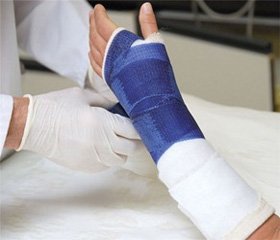Журнал «Травма» Том 16, №2, 2015
Вернуться к номеру
Structural and functional state of vessels in disorders of reparative osteogenesis at hyperhomocysteinemia and associated violations
Авторы: I. A. Bezsmertnyi - Scientific research institute of invalid rehabilitation of Vinnitsa national Pirogov memorial medical university, Vinnitsa, Ukraine
Рубрики: Травматология и ортопедия
Разделы: Клинические исследования
Версия для печати
intraosseous phlebography, hyperhomocysteinemia, osteogenesis, blood vessels, genetic polymorphism.
Summary.
Reparative bone regeneration is a complex, genetically programmed process, which depends on the characteristics of many factors. One of these factors is hyperhomocysteinemia. Against the background HHcy and associated molecular genetic disorders disorders reparative osteogenesis may be implied by structural and functional changes of vessels damaged limbs that as at the time of injury, and in the process of restoring bone defining features of its course.
The purpose of the study is to explore the features of structural and functional state of vessels, their changes depending on the type of bone formation in patients with nonunion of long bones at HHcy and related molecular genetic disorders and their comparison with the data of people with traditional factors dysregeneration.
Material and methods. Hyperhomocysteinemia diagnosed in 33 patients with bone nonunion of tibia. Average age – 40,4±1,91 years. Men were – 26 (78.8%), women – 7 (21.2%). Duration of disease 7,5-39 months. Normoplastic type of bone nonunion was – 9, hyperplastic – 6, hypoplastic – 10, atrophic – in 8 patients. Combining HHcy with aberrant levels of inflammatory mediators C-reactive protein (> 5.0 mg / L) and interleukin-6 (> 9.0 ng / L) was diagnosed in 19 (57.57%), HHcy with mutation of the gene MTHFR C677T ( 677-TT genotype) - 6 (18.18%), HHcy with mutation of the gene eNOS T786C (genotype CC-786) – 5 (15.15%), and HHcy with combined mutation of both genes (MTHFR 677 TT + eNOS 786-SS) – 3 (9.1%) patients. The control group was consisted of 12 patients with bone nonunion of tibia due to the influence of traditional factors dies regeneration. In biochemical studies determined levels of HHcy, interleukin-6, C-reactive protein. We investigated the gene polymorphism of enzymes HHcy - MTHFR C677T and endothelial nitric nitrogen monoxide (eNOS T786C). Structural and functional condition of the damaged limb veins assessed by radiographic intraosseous phlebography results.
Results and discussion. In patients with nonunion of long bones at the HHcy and associated violations registered more expressive structural and functional changes in venous vessels and bone tissue paraosseous, compared with patients of traditional factors dysregeneration. These changes manifestated uneven, delayed and selective contrast intraosseous, paraosseous and periosteal vessels. deformation of central venous channel formation with numerous twists and abnormal extensions, areas of abrupt interruption of contrast distribution. These changes showed marked disturbances of venous blood flow and development intraosseous venous hypertension. The severe structural and functional changes of vessels damaged limbs often recorded among patients with hypo- and atrophic types of bone nonunion and associated with abnormal genotypes MTHFR 677-TT, eNOS786-CC and combined mutation of MTHFR 677-TT + eNOS 786-CC.
Conclusions
1. In patients with nonunion of long bones at the HHcy and associated disorders was defined structural and functional changes in venous vessels damaged limbs, it was manifested signs of venous hypertension in violation of intraosseous contrast, periosteum and periosseous vessels.
2. Among patients with impaired reparative osteogenesis in HHcy and related metabolic disorders are defined moderate structural and functional changes in the veins as pathological tortuosity and deformation of central venous sinus, uneven distribution and dissemination of deferred contrast to intraosseous and periosteal vessels, along with preservation contrasting paraosseous vessels.
3. Among patients with hypo- and atrophic types of bone nonunion often recorded pronounced structural and functional changes of vessels damaged limbs associated with abnormal genotypes MTHFR 677-TT, eNOS786-CC and combined mutation of MTHFR 677-TT + eNOS 786-CC. These changes are characterized uneven distribution and delayed contrast medium in extended sinuses bone marrow postponed its distribution by periosteal vessels, absence or significant shortfall (more than 50%) of all orders contrasting veins to large non-vascular areas.

